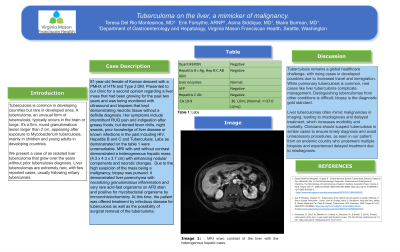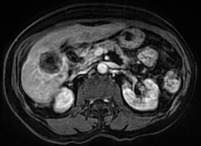Monday Poster Session
Category: Liver
P3031 - Tuberculoma on the Liver: A Mimicker of Malignancy
Monday, October 28, 2024
10:30 AM - 4:00 PM ET
Location: Exhibit Hall E

Has Audio

Teresa Del Rio Montesinos, MD
Virginia Mason Franciscan Health
Seattle, WA
Presenting Author(s)
Teresa Del Rio Montesinos, MD, Erin Forsythe, ARNP, Asma Siddique, MD, Blaire Burman, MD
Virginia Mason Franciscan Health, Seattle, WA
Introduction: Tuberculosis is common in developing countries but rare in developed ones. A tuberculoma, an unusual form of tuberculosis, typically occurs in the brain or lungs. It's a firm, round granulomatous lesion larger than 2 cm, appearing after exposure to Mycobacterium tuberculosis, mainly in children and young adults in developing countries.
We present a case of an isolated liver tuberculoma that grew over the years without prior tuberculosis diagnosis. Liver tuberculomas are extremely rare, with few reported cases, usually following miliary tuberculosis.
Case Description/Methods: 81 year old female of Korean descent with a PMHX of HTN and Type 2 DM. Presented to our clinic for a second opinion regarding a liver mass that had been growing for the past two years and was being monitored with ultrasound and biopsies that kept demonstrating necrotic tissue without a definite diagnosis. Her symptoms include intermittent RUQ pain and indigestion after greasy foods, but denied fever chills, night sweats and prior knowledge of liver disease or known infections in the past including HIV, Hepatitis B and C and Tuberculosis. Labs as demonstrated on the table 1 were unremarkable. MRI with and without contrast demonstrated a heterogeneous hepatic mass (4.3 x 4.3 x 3.7 cm) with enhancing nodular components and necrotic changes. Biopsy of the mass was pursued; liver parenchyma with necrotizing granulomatous inflammation and very rare acid-fast organisms on AFB stain and positive for mycobacterial organisms by immunohistochemistry. At this time the patient will be offered treatment by infectious disease as well as possibility of surgical removal of the tuberculoma.
Discussion: Tuberculosis remains a global healthcare challenge, with rising cases in developed countries due to increased travel and immigration. While pulmonary tuberculosis is common, rare cases like liver tuberculoma complicate management. Distinguishing tuberculomas from other conditions is difficult; biopsy is the diagnostic gold standard.
Liver tuberculomas often mimic malignancies in imaging, leading to misdiagnosis and delayed treatment, which increases morbidity and mortality. Clinicians should suspect tuberculosis in similar cases to ensure timely diagnosis and avoid unnecessary procedures, as seen in our patient from an endemic country who underwent multiple biopsies and experienced delayed treatment due to misdiagnosis.

Note: The table for this abstract can be viewed in the ePoster Gallery section of the ACG 2024 ePoster Site or in The American Journal of Gastroenterology's abstract supplement issue, both of which will be available starting October 27, 2024.
Disclosures:
Teresa Del Rio Montesinos, MD, Erin Forsythe, ARNP, Asma Siddique, MD, Blaire Burman, MD. P3031 - Tuberculoma on the Liver: A Mimicker of Malignancy, ACG 2024 Annual Scientific Meeting Abstracts. Philadelphia, PA: American College of Gastroenterology.
Virginia Mason Franciscan Health, Seattle, WA
Introduction: Tuberculosis is common in developing countries but rare in developed ones. A tuberculoma, an unusual form of tuberculosis, typically occurs in the brain or lungs. It's a firm, round granulomatous lesion larger than 2 cm, appearing after exposure to Mycobacterium tuberculosis, mainly in children and young adults in developing countries.
We present a case of an isolated liver tuberculoma that grew over the years without prior tuberculosis diagnosis. Liver tuberculomas are extremely rare, with few reported cases, usually following miliary tuberculosis.
Case Description/Methods: 81 year old female of Korean descent with a PMHX of HTN and Type 2 DM. Presented to our clinic for a second opinion regarding a liver mass that had been growing for the past two years and was being monitored with ultrasound and biopsies that kept demonstrating necrotic tissue without a definite diagnosis. Her symptoms include intermittent RUQ pain and indigestion after greasy foods, but denied fever chills, night sweats and prior knowledge of liver disease or known infections in the past including HIV, Hepatitis B and C and Tuberculosis. Labs as demonstrated on the table 1 were unremarkable. MRI with and without contrast demonstrated a heterogeneous hepatic mass (4.3 x 4.3 x 3.7 cm) with enhancing nodular components and necrotic changes. Biopsy of the mass was pursued; liver parenchyma with necrotizing granulomatous inflammation and very rare acid-fast organisms on AFB stain and positive for mycobacterial organisms by immunohistochemistry. At this time the patient will be offered treatment by infectious disease as well as possibility of surgical removal of the tuberculoma.
Discussion: Tuberculosis remains a global healthcare challenge, with rising cases in developed countries due to increased travel and immigration. While pulmonary tuberculosis is common, rare cases like liver tuberculoma complicate management. Distinguishing tuberculomas from other conditions is difficult; biopsy is the diagnostic gold standard.
Liver tuberculomas often mimic malignancies in imaging, leading to misdiagnosis and delayed treatment, which increases morbidity and mortality. Clinicians should suspect tuberculosis in similar cases to ensure timely diagnosis and avoid unnecessary procedures, as seen in our patient from an endemic country who underwent multiple biopsies and experienced delayed treatment due to misdiagnosis.

Figure: MRI w/wo contrast of the liver.
Note: The table for this abstract can be viewed in the ePoster Gallery section of the ACG 2024 ePoster Site or in The American Journal of Gastroenterology's abstract supplement issue, both of which will be available starting October 27, 2024.
Disclosures:
Teresa Del Rio Montesinos indicated no relevant financial relationships.
Erin Forsythe indicated no relevant financial relationships.
Asma Siddique indicated no relevant financial relationships.
Blaire Burman indicated no relevant financial relationships.
Teresa Del Rio Montesinos, MD, Erin Forsythe, ARNP, Asma Siddique, MD, Blaire Burman, MD. P3031 - Tuberculoma on the Liver: A Mimicker of Malignancy, ACG 2024 Annual Scientific Meeting Abstracts. Philadelphia, PA: American College of Gastroenterology.
